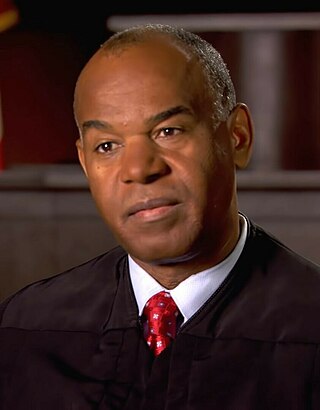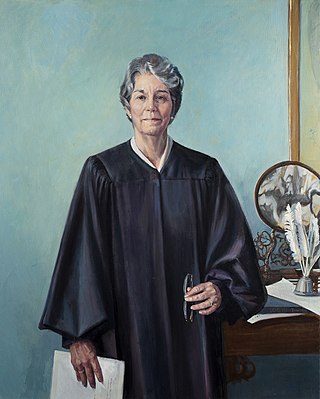Lemon v. Kurtzman, 403 U.S. 602 (1971), was a case argued before the Supreme Court of the United States. The court ruled in an 8–0 decision that Pennsylvania's Nonpublic Elementary and Secondary Education Act from 1968 was unconstitutional and in an 8–1 decision that Rhode Island's 1969 Salary Supplement Act was unconstitutional, violating the Establishment Clause of the First Amendment. The act allowed the Superintendent of Public Schools to reimburse private schools for the salaries of teachers who taught in these private elementary schools from public textbooks and with public instructional materials.

The Roberts Court is the time since 2005 during which the Supreme Court of the United States has been led by John Roberts as Chief Justice. Roberts succeeded William Rehnquist as Chief Justice after Rehnquist's death.

Roger Lee Gregory is an American lawyer who serves as a United States circuit judge of the United States Court of Appeals for the Fourth Circuit.

Paul Victor Niemeyer is a United States circuit judge of the United States Court of Appeals for the Fourth Circuit and a former United States District Judge of the United States District Court for the District of Maryland.

Deborah Havis Koss Chasanow is a senior United States district judge of the United States District Court for the District of Maryland.

Stephanie Dawn Thacker is a United States circuit judge of the United States Court of Appeals for the Fourth Circuit.

The Supreme Court of the United States handed down eight per curiam opinions during its 2013 term, which began October 7, 2013 and concluded October 5, 2014.

The Supreme Court of the United States handed down eighteen per curiam opinions during its 2015 term, which began October 5, 2015 and concluded October 2, 2016.

The Peace Cross is a World War I memorial located in Bladensburg, Maryland. Standing 40 feet (12 m) in height, the large cross, is made of tan concrete with exposed pink granite aggregate; the arms of the cross are supported by unadorned concrete arches. Erected by 1925 in the memory of 49 local servicemen from Prince George's County who died during World War I, the base of the cross displays the words "valor," "endurance," "courage," and "devotion" as well as a bronze tablet listing the names of those lost in combat.

The Supreme Court of the United States handed down nine per curiam opinions during its 2016 term, which began October 3, 2016 and concluded October 1, 2017.
Sessions v. Dimaya, 584 U.S. ___ (2018), was a United States Supreme Court case in which the Court held that 18 U.S.C. § 16(b), a statute defining certain "aggravated felonies" for immigration purposes, is unconstitutionally vague. The Immigration and Nationality Act (INA) classifies some categories of crimes as "aggravated felonies", and immigrants convicted of those crimes, including those legally present in the United States, are almost certain to be deported. Those categories include "crimes of violence", which are defined by the "elements clause" and the "residual clause". The Court struck down the "residual clause", which classified every felony that, "by its nature, involves a substantial risk" of "physical force against the person or property" as an aggravated felony.

The Supreme Court of the United States handed down seven per curiam opinions during its 2018 term, which began October 1, 2018, and concluded October 6, 2019.
Iancu v. Brunetti, No. 18–302, 588 U.S. ___ (2019), is a Supreme Court of the United States case related to the registration of trademarks under the Lanham Act. It decided 6–3 that the provisions of the Lanham Act prohibiting registration of trademarks of "immoral" or "scandalous" matter is unconstitutional by permitting the United States Patent & Trademark Office to engage in viewpoint discrimination, which violates the Free Speech Clause of the First Amendment.
Gundy v. United States, No. 17-6086, 588 U.S. ___ (2019), was a United States Supreme Court case that held that 42 U.S.C. § 16913(d), part of the Sex Offender Registration and Notification Act ("SORNA"), does not violate the nondelegation doctrine. The section of the SORNA allows the Attorney General to "specify the applicability" of the mandatory registration requirements of "sex offenders convicted before the enactment of [SORNA]". Precedent is that it is only constitutional for Congress to delegate legislative power to the executive branch if it provides an "intelligible principle" as guidance. The outcome of the case could have greatly influenced the broad delegations of power Congress has made to the federal executive branch, but it did not.

The Supreme Court of the United States handed down ten per curiam opinions during its 2019 term, which began October 7, 2019 and concluded October 4, 2020.
Department of Homeland Security v. Thuraissigiam, 591 U.S. ___ (2020), was a United States Supreme Court case involving whether the Illegal Immigration Reform and Immigrant Responsibility Act of 1996, which limits habeas corpus judicial review of the decisions of immigration officers, violates the Suspension Clause of Article One of the U.S. Constitution. In the 7–2 opinion, the Court ruled that the law does not violate the Suspension Clause.
Agency for Int'l Development v. Alliance for Open Society International, 591 U.S. ___ (2020), also known as Alliance for Open Society II, was a United States Supreme Court case in which the Court held that compelled speech required as a condition for funding on foreign non-governmental affiliates of U.S. non-government organizations does not violate First Amendment rights.
Barr v. American Assn. of Political Consultants, Inc., 591 U.S. ___ (2020), was a United States Supreme Court case involving the use of robocalls made to cell phones, a practice that had been banned by the Telephone Consumer Protection Act of 1991 (TCPA), but which exemptions had been made by a 2015 amendment for government debt collection. The case was brought by the American Association of Political Consultants, an industry trade group, and others that desired to use robocalls to make political ads, challenging the exemption unconstitutionally favored debt collection speech over political speech. The Supreme Court, in a complex plurality decision, ruled on July 6, 2020, that the 2015 amendment to the TCPA did unconstitutionally favor debt collection speech over political speech and violated the First Amendment.

The Supreme Court of the United States handed down fourteen per curiam opinions during its 2020 term, which began October 5, 2020 and concluded October 3, 2021.
National Pork Producers Council v. Ross, 598 U.S. 356 (2023), was a United States Supreme Court case related to the Dormant Commerce Clause.









